SEMANA SANTA (continued)...
We began the week feeling there was no need to see every single procession, worried that we would tire of the whole thing by the end of the week. But we soon found ourselves swept up by the enthusiasm of Granada and started to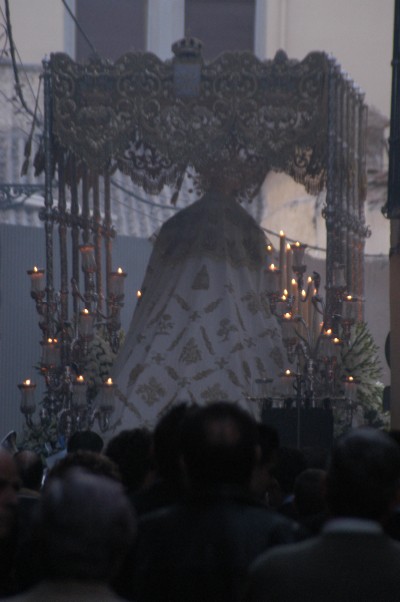 appreciate the drama of the event. Each group created its own atmosphere with the colors of their garments, the use of instruments, the symbolism of what they held, and the images of Jesus and Mary that they carried through the streets. Some processions were accompanied by bold, powerful sounds from horns and drums while another would have just the heavy beat of drums; yet another would not have a band at all, just silence. One platform was made of ornately carved wood while the next was gilded. The images of Our Lady of Alhambra was carried on a silver replica of the Alhambra Palace. appreciate the drama of the event. Each group created its own atmosphere with the colors of their garments, the use of instruments, the symbolism of what they held, and the images of Jesus and Mary that they carried through the streets. Some processions were accompanied by bold, powerful sounds from horns and drums while another would have just the heavy beat of drums; yet another would not have a band at all, just silence. One platform was made of ornately carved wood while the next was gilded. The images of Our Lady of Alhambra was carried on a silver replica of the Alhambra Palace.
By the end of the first night we had caught each of the five processions at some stage in their journey. We wedged ourselves in along the front of a building to catch the image of Jesus Despojado (1989) pass by and enter the Catedral. The large platform lowered directly in front of us, the wood creaking under the weight. When the bearers hoisted the icon back to their shoulders I felt a moment of anxiety as I considered what would happen if they lost their footing and that heavy pedestal went the wrong way. Small children were running in and out of the stalled procession to collect wax dripping from the long candles. They were amassing large balls of sacred wax, making a bit of a competition out of it. The young attendants in the procession periodically took exception to this because it was their job to be collecting the wax from the dripping candles as well as attend to the people in their procession by lighting candles and handing out 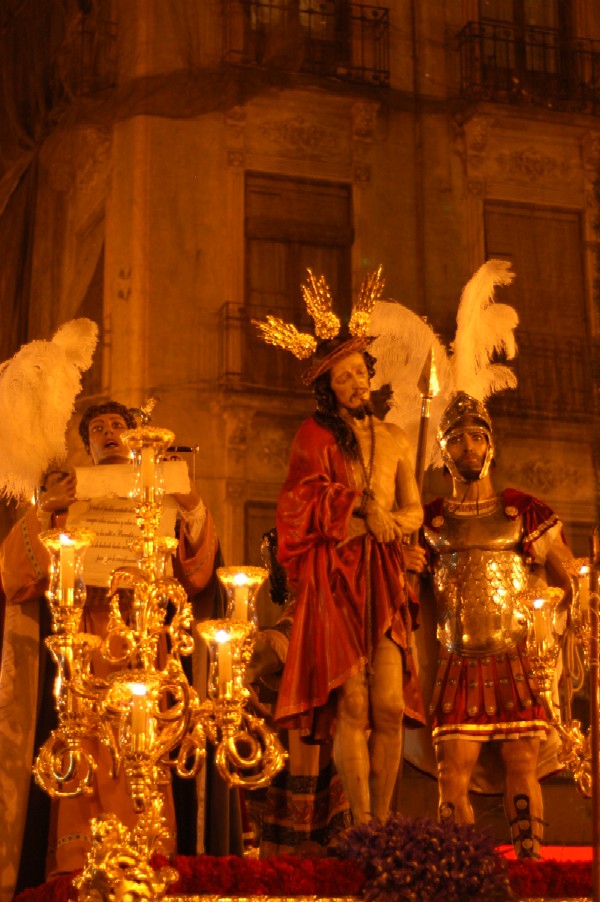 water and candies. water and candies.
Throughout the week the various stages of the cross were represented in one or more of the processions. Nearly every procession had one icon of Jesus followed by an icon of Mary. Each image was a work of art as much as they were a piece of history. The oldest icon dated back to 1513. In the evenings we discovered that we could walk around to the churches and view the icons inside the main chapels. Having time to look more closely at images and their elaborate pedestals gave us a greater appreciation for the workmanship involved. The great care taken in carrying the icons was not just to add drama to the event but was ensure the safety of these precious works of art.
As the week went on more and more tourists arrived and the evenings became more crowded but still maintained a solemn respect for the event. From Wednesday onwards some of the more famous processions began to appear. The colorful collage of Los Gitanos (the gypsies) with their purple robes, red hoods, and bright yellow capes made its way down Via de Colon as it neared sunset. Their return journey took them all of the way up to the Abby in Sacromonte, the gypsy quarter behind Albayzin, through the winding cobblestone streets of the Moorish old town and up the steep hill. It lasted all night. 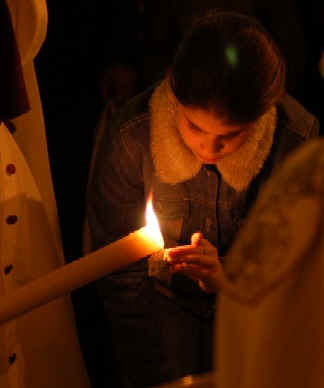
When Thursday arrived the weather started to sour, with rain coming down sporadically. The first procession we tried to catch was Estrella which was scheduled to depart at 6:00 and pass through the Albayzin. We waited along with many others for the images of Jesus de la Pasion (1984) and the Virgin de la Estrella (1980) to arrive but they never came. Passing by the Church of San Miguel Bajo in the Albayzin we found a crowd of people crammed around the narrow streets in front of the door. The band was squealing and we could just see the image at the door of the church. There was no way to get a good view so we waited for the procession to start down the street. It never happened. We could hear passionate voices serenading the icons from the doorway and this was as far as they would go. The weather had gotten better but with the risk of rain it was too dangerous to take the icons from their sacred homes. The devoted sang out gloriously in appreciation of Christ and his mother before the icons were carefully returned to their homes to wait another year before they could parade around the streets of Granada. The images were often serenaded as they were put away at the end of a procession. The worshippers of these icons wouldn't let them be returned to their cozy altars without that final tribute.
As we started to make our way down the streets of Albayzin it started to rain again. It became even more clear why the icons weren't brought into the old cobblestone streets. Just walking in shoes it was hard not to slip and fall. There was no way that twenty people hidden under a platform could safely walk these streets. After the weather had been clear for some hours we were hopeful that the Silencio procession might take place. The black clad procession was unique in that it moved in complete silence through the darkened streets of Granada all night long. We went to meet the icon at the Church of Saint Nicholas as the very top of Albaycin until we realized that it was departing from another church down the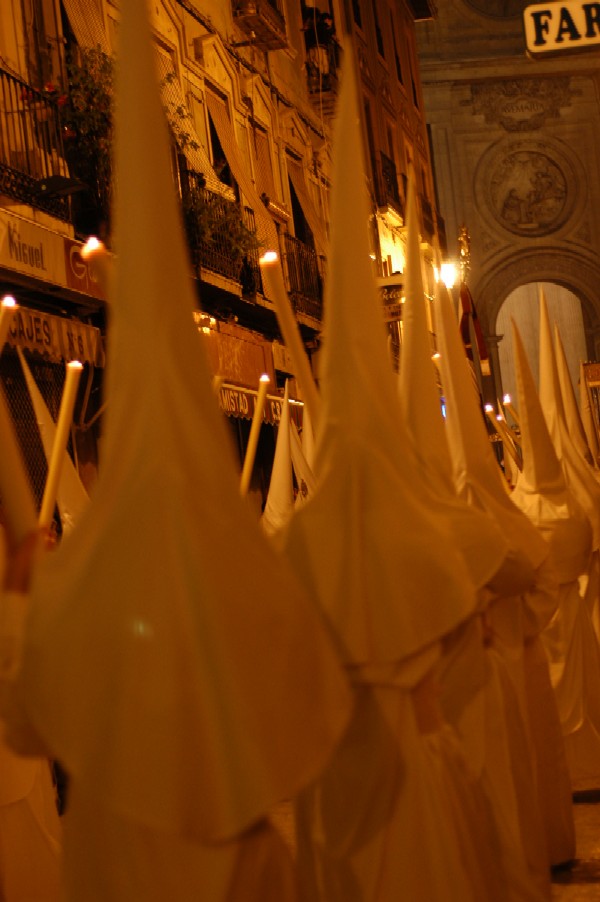 hill. At the Church of San Jose, along the river below the old quarter, we found a crowd of people. The gate was close and it was quiet, only whispers here and there as people tried to figure out what was going on. We waited. Eventually the doors of the church slowly opened and then the gates were unlocked. People gently pushed and shoved their way into the garden before the door. The church was dark but the chilling figure of Jose de Mora (1695), Christ on the Cross, stood at the door way, only illuminated by dim light. Everyone stood quietly as they jockeyed around for a place to see clearly. This procession would never leave the church but tradition also didn't allow for any serenading. The tone was of quiet and mourning. hill. At the Church of San Jose, along the river below the old quarter, we found a crowd of people. The gate was close and it was quiet, only whispers here and there as people tried to figure out what was going on. We waited. Eventually the doors of the church slowly opened and then the gates were unlocked. People gently pushed and shoved their way into the garden before the door. The church was dark but the chilling figure of Jose de Mora (1695), Christ on the Cross, stood at the door way, only illuminated by dim light. Everyone stood quietly as they jockeyed around for a place to see clearly. This procession would never leave the church but tradition also didn't allow for any serenading. The tone was of quiet and mourning.
The rain kept the Friday processions inside as well but by Saturday they were able to make their one scheduled procession of Our Lady of Alhambra (1750-1760), a touching image of Mary sitting with Jesus in her lap, towering on a platform of the Alhambra palace. On Sunday three final procession brought an end to the Semana Santa. The weather was beautiful for Easter Mass and a group of children made the first procession of the day by carrying their small image of Christ as a boy into the Catedral for the 1:00 mass. Ringing terracotta bells as they entered the cavernous church the group halted its procession at the altar and rested their image near the front. The priest was in a delightful mood and took great pleasure in sprinkling everyone with his holy water before he began the service. The Catedral was packed with people, all dressed in their Easter best. Once the mass was concluded the children picked up their icon and carefully proceeded out of the main doorway and back through the streets of Granada to return their images to their church.
The last procession that we waited to catch was an image of Christ Resurrected that triumphantly crossed the Rio Genil in the afternoon. The procession made its way up a wide promenade into the center of the city and brought a lighten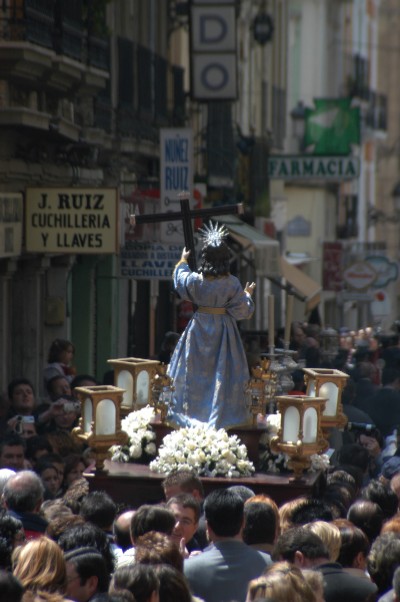 ed tone to a week of solemnity. We were prepared to leave that procession as our last but as it got later in the evening we couldn't resist running out to catch the very last images of the last procession return home. We arrived just as they were putting the vibrant image of Christ Resurrected under cover. It was an exceptional figure of Christ walking gallantly, hair flowing, face smiling, and legs and arm in active motion. Moving along on his platform made the image come to life. Following behind him was a unique and beautiful image of Mary with her long blue dress flowing, eyes bright, as she followed her son into Heaven. It had been well worth that last effort to see these final glorious images complete the long and emotional week of Semana Santa. ed tone to a week of solemnity. We were prepared to leave that procession as our last but as it got later in the evening we couldn't resist running out to catch the very last images of the last procession return home. We arrived just as they were putting the vibrant image of Christ Resurrected under cover. It was an exceptional figure of Christ walking gallantly, hair flowing, face smiling, and legs and arm in active motion. Moving along on his platform made the image come to life. Following behind him was a unique and beautiful image of Mary with her long blue dress flowing, eyes bright, as she followed her son into Heaven. It had been well worth that last effort to see these final glorious images complete the long and emotional week of Semana Santa.
Festivals are a wonderful way to experience a country. They can be so revealing about a place and its people. To call Semana Santa (Saint’s Week) a festival is perhaps misleading because of its somber tone but the social atmosphere and sense of community made a statement about the people of Anadalucia. Through of week of these processions we never tired of watching them and the experience was worth visiting a hundred historical sites or monuments. |

